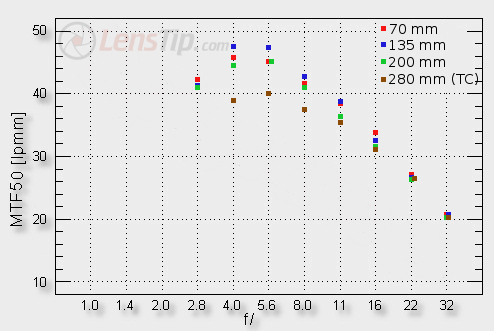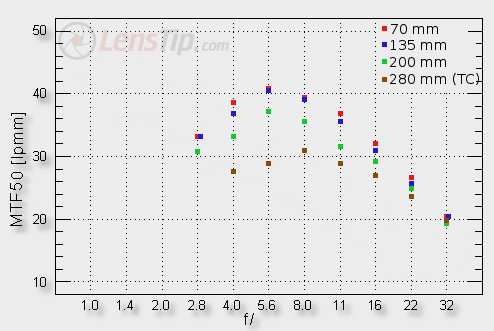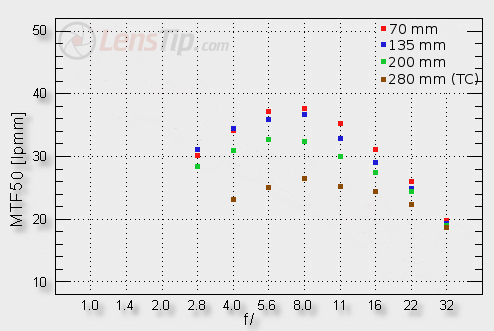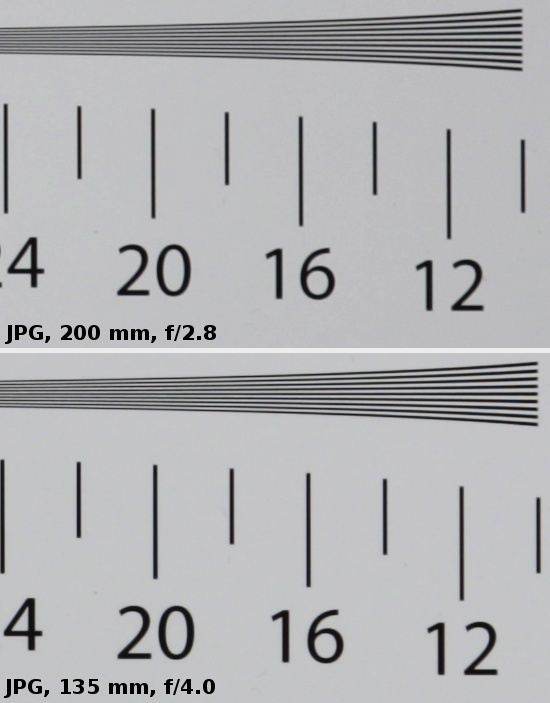Canon EF 70-200 mm f/2.8L IS II USM
4. Image resolution
Let’s see how the Canon 70-200 mm f/2.8 fares in the frame centre at 70, 135 and 200 mm focal length and after attaching the original TC1.4x converter (version II, as version III was still unavailable on the market). The results are presented on the graph below.

Please Support UsIf you enjoy our reviews and articles, and you want us to continue our work please, support our website by donating through PayPal. The funds are going to be used for paying our editorial team, renting servers, and equipping our testing studio; only that way we will be able to continue providing you interesting content for free. |
- - - - - - - - - - - - - - - - - - - - - - - - - - - - - - - - - - - - - - - - - - - - - - - -
Practically everything deserves to be praised here. Firstly, we see a very even performance at all focal lengths. Although the 200 mm focal length seems to lag behind very slightly, the effect is insignificant, actually bordering the margin of error, noticeably weaker than in the case of immediate competitors of the Canon. Second major thing are the results at the maximum relative aperture – extremely important for this type of device. Here, at all focal lengths the lens exceeds 40 lpmm so it is able to generate very sharp pictures. The new Canon doesn’t have to be stopped down so you can enjoy fully sharp photos.
The third issue is the performance on slight stopping down. The lens fares here as well as the best “primes”. The results at 135 mm, by f/4.0 and by f/5.6 are close to records; in fact many fixed focal lenses, considered to be good, can only dream about such achievement.
The fourth factor considers the cooperation with a converter. Older versions of 70-200 mm lenses, even after attaching an original converter, produced images of only average quality. Here, the situation improved a lot. We don’t see such results as in the 70-200 mm range but still we reach 40 lpmm (and near the maximum aperture to boot) so very sharp images and fully useful photos are guaranteed.
When it comes to the performance in the frame centre the Canon 70-200 mm f/2.8 is simply beyond reproach. Let’s check whether you can have some reservations about the achievements at the edge of the APS-C sensor. The appropriate graph is presented below.

Once again you can only clap and cheer. In the whole focal lengths range, even at the maximum relative aperture, the lens doesn’t have any problems with exceeding the decency level, which, in the case of the tests conducted on 1 Ds MkIII, is set at 30 lpmm. On slight stopping down we get very good, crisp and sharp images.
The performance with the converter attached is an exception to the rule. As in the frame centre we didn’t have any reservations whatsoever, the edge of the APS-C sensor made us sniff at the results several times. The full usefulness is reached near f/8.0 there. Fortunately, by f/4.0 and f/5.6, these values are not much lower as they border these 30 lpmm. What’s important, the improvement can be seen and it is clearly noticeable, especially compared to the results of the predecessors.
Let’s progress to the discussion about the results obtained on the edge of full frame. On account of its significant dimensions and the high number of pixels, the full frame edge is problematic even for optical devices of the highest class. Most of fast or moderately fast lenses experience problems with getting useful sharpness near the maximum relative aperture. On the graph below we present the achievements of the tested Canon.

At first glance you can tell the situation is very good. In the 70-135 mm range we can’t carp about anything because there, even at the maximum relative aperture, the image is acceptably sharp. The 200 mm focal length lags behind a bit more and that’s why in its case the maximum aperture is a tad below the decency level. Still, the result is not bad at all. On stopping down the aperture the MTF50 values, reached at the maximum focal length, don’t increase as fast as at the shorter end. You can find out in the next chapter that the lateral chromatic aberration is responsible for it, as at 200 mm it increases on stopping down and doesn’t allow the lens to spread its wings to the full.
The crisis during the cooperation with the converter, visible on the APS-C sensor’s edge, is even more pronounced at the edge of full frame. In this case we must take into account weak sharpness and even the stopping down won’t help us a lot.
To sum up the Canon EF 70–200 mm f/2.8L IS II USM is the sharpest lens of the 70-200 mm class we have had the pleasure of testing so far. It fares a bit better than the rival Nikkor 70–200 mm f/2.8 VR II and noticeably better than the new Sigma 70-200 mm OS. These two rival lenses are for a change significantly better than the older, stabilized version of the Canon 70-200 mm f/2.8. It proves that the professional optics has been indeed progressing lately by leaps and bounds.
At the end we would like to present some crops of our test chart, which were taken from the frame centre; we cropped JPEG files which were saved along RAW files.
 |






